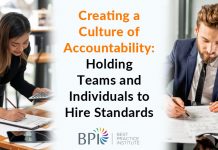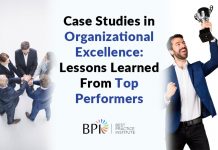Metaphors are tricky. Because they are non-literal, they are tough to keep tabs on. They can occur too frequently. They can be pushed to the edge of their meaning and utility. “Agility” runs that risk when used in Human Resources.
Legacy Human Resources has been a discipline of compliance, adherence, and precedence. Heritage HR existed to tow the line, follow the arrows, and stick to the rules. Status quo and stability marked its plan and purpose with little tolerance for autonomy or flexibility.
However, “agile” (adjective, noun, adverb, and more) thinking has become part of the HR lexicon. Agile so dominates management thought and theory we sometimes struggle sharing the definition and use.
We recently reached out to a well-selected team of leading HR strategists to discuss their best and next practices in How to Measure Learning Agility when Assessing Leader Potential. The conversation proved interesting – even in its inconclusive conclusion.
Agile behavior and learning agility
Agile Behavior and Learning Agility are not the same thing.Agile Thinking assumes organizations are organic. Organizations belong to systems of systems where everything occurs within an evolving context. It relies on teams empowered and enabled to act with ad hoc energy at touchpoints in a process that need attention. It accepts that production is not straight lined. At moments of friction, disruption, or weakness, teams roll in to resolve the apparent problem. Then, the team members return to their readiness position.
- Agile Behaviors are measurable observable actions on the part of people in the conception, design, production, and delivery of products and services. Agility should not dismiss or disdain processes in place, but the process has strategic room for focus, analysis, and reconfiguration.
Agile Behaviors are nimble, swift, and baggage-free. They include that brain and brawn reserve to stop on a dime, pivot, and make the skillful shot. You might think of the college basketball player – performing under tremendous emotional, psychological, and sensory – who weaves through offense and defense to stop, turn, and arch to launch a ball for three points at the bell ending overtime. There seems to be something of destiny in that agile move.
There are many tests – and more are in development – used in the assessment of leadership potential. A combination of observed and valued KPIs relate to Agility including:
| Alacrity | Adaptivity | Change Able |
| Collaborative | Engaging | Knowledge Sharing |
| Initiative | Innovative | Integrity |
| Nurturing | Outreach | Passionate |
| Relationship Building | Respect | Responsiveness |
| Teamwork | Transparent | Trustworthy |
- Learning Agility, however, is another KPI. It refers to the use of learning quickly, richly, and effectively. It requires awareness, comprehension, and discernment to define targets in volatile and dynamic contexts.
Learning Agility is a human characteristic that is reflective, responsive, and resourceful. However, framing a best next practice proved a challenge for our group of future-forward professionals.
Five questions to frame a conversation:
BPI’s experts broke into two groups to answer the following questions:
- I define “learning agility” as…
- I suggest driving the use of learning agility when measuring potential by…
- I assess learning agility by…
- We develop this competency by…
- I get leaders to care about learning agility by doing …
The following exchange offered invaluable insights, new vocabulary, and alternative views. Still, we may not have quite nailed the definition and best practice for measuring Learning Agility when assessing leader potential.
1. Define “learning agility” as…
Learning Agility is a competency demonstrated by the ability to learn something in one context and to apply it in a different context. But the competency is marked by speed, efficiency, and accuracy.
This competency observes, appraises, and integrates lessons learned in one context and uses them as learned or as adapted in a new context. It demands a fluid, flexible, and dynamic approach to learning objectives and methodologies as well as the ability to assimilate, discriminate, and optimize the core experience.
Learning Agility is a characteristic of leadership;it is not learning about Agility. Put somewhat simply, Learning Agility requires a capacity to recognize, reflect, and respond in challenging moments and contexts.
2. Driving the use of Learning Agility when measuring potential by…
Learning Agility may be a new term or concept to the high potential being assessed. An assessment offers an opportunity to introduce the values added by Learning Agility. However, the conversation must build a mutual understanding of the idea and the metrics available.
Nonetheless, Learning Agility is a performance characteristic that may integrate other assessment KPIs. In short, the organization requires leaders with high potential for:
- realizing challenges for what they are,
- reflecting on the pros, cons, and integrating options in the moment, and
- responding with skillful action and decision-making.
How we measure the courage to act in the context, the capacity to discern, and the deftness of the action remains difficult.
3. Assessing learning agility by…
In the absence of formal tools, assessment of Learning Agility relies on potentially subjective measures. We lack the psychometric assessments that might help. However, there is some consistent thinking about the relevance of certain behaviors. For example, people with Learning Agility seem generally curious, curious in the sense that they lack some comfort with the status quo. They are inclined “to push the envelope.” They eagerly accept stretch assignments, new business roles, and more.
They are creative, imaginative, and quick to see the meaningful target among other targets. They are inclined toward future forward thinking. And, they understand a future forward organization is a work in progress.
Learning Agility can respond quickly because it is not burdened with baggage. Formal training and development may load the Hi-Po with policy and procedure. However, in moments of high consequence, the person must have the autonomy to respond with some well-tempered instinct as well as classroom information. Learning Agility is revealed at that moment of reflection –between receiving/registering the data and the responding to that stimulus.
Moreover, such candidates seem imminently coachable. They understand learning integrates data and information, so they seek learning experiences and remain open to feedback. They demonstrate an eagerness to use the learning experienced.
4. Developing this capacity by…
The benchmarking participants struggled to decide if Learning Agility can be developed. There is something intuitive and spontaneous that may be instinct rather than skill. There is some feeling that some people have the capacity, and some do not.
Our contributors do not know of any current formal T&D or assessment tool. However, believing that every individual can learn incrementally, they are open to additional research on the concept.
Meanwhile, they can encourage individual development by creating and sustaining a culture that enables responsiveness. They can sustain an environment of care, concern, and emotional connectedness supporting individual trials in Learning Agility. Subjects need opportunities to identify and sort through options before making difficult choices. They must understand they have permission to take risks – and to fail.
5. Getting leaders to care about Learning Agility by doing …
Getting the C-suite to care about Learning Agility presents some challenge. If this is a starting point, it may mean revisiting and revitalizing the culture. It certainly means offering a clear definition to the executive level, and we may still be wrestling with that.
Learning Agility must be worked into the language of the organization, its values, and its purpose. Talented people considered for advancement must understand its importance from orientation. And, a focus on Learning Agility could become the framework for prioritization and integration of all training components because it takes us from learning as an ongoing process to learning as an increasingly fast piece of the larger picture.
As a critical component of high potential assessment, a critical leadership competency, Learning Agility is not episodic. It is not the stuff of three-ring binders and training units. We do not know if you can develop Learning Agility if you do not have the capacity now. While we may not be ready to go from 0 to 60 at this time, we believe everyone can grow incrementally.
Executive leaders as well as the people assessed must see a commitment to its importance. But that takes clarification and some sense of framework, both of which need some thoughtful and meaningful development.
Our benchmark is fuzzy –for the moment!
Our panel of distinguished chief HR and Talent officers met to explore the topic of assessing Learning Agility among high potential staff. There was consensus on its existence and importance, but we struggled for a definition with proven utility for measuring Learning Agility performance and potential.
The collaboration did favor a definition that places Learning Agility between reception of stimuli and a skillful response in multifaceted contexts. It is a function of time, talent, and risk. If we could fix Learning Agility, it would be at the moment of pivoting.

While we lack the psychometric tools to assess Learning Agility, there is consensus that it exists and shows itself in certain behaviors in evolving contexts. Theoretically, we can design metrics based on successful behaviors in volatile environments. We can imagine metrics reporting on the capacity to learn, adapt, and apply despite challenging circumstances.
Absent that, we could customize what we have or build a more holistic approach. The participants agreed on the 3-Cs:
- Learning Agility is critical to the individual and organization.
- Learning Agility is necessary to the resolution of complex challenges.
- Learning Agility is apparent in the curious behavior of high potential leaders.
Learning Agility is positive and constructive self-awareness occasioned by volatile challenges and environments. If it is an instinct to survive when tasked, it still reveals itself in agile response. If its occurrence in behavior has parameters, we should be able to measure it. However, until we have a firm definition, Learning Agility may be a tough sell to the most senior stakeholders.










